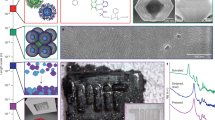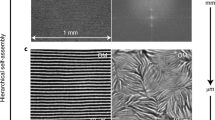Abstract
A significant challenge faced in the use of nanoscale building blocks is developing parallel methods for interconnecting and patterning assemblies of the individual components. Molecular or polymeric scaffolds hold promise as a means of preparing closely spaced, specifically arranged nanoscale assemblies. Here we show how a biopolymer, DNA, can be used as a scaffold for the assembly of extended, close-packed, ligand-stabilized metal nanoparticle structures, including several desirable architectures (such as lines, ribbons, and branches). Electrostatic binding of ligand-stabilized nanoparticles to the DNA backbone results in extended linear chain-like structures, ribbon-like structures composed of parallel nanoparticle chains, and branched structures. High-resolution transmission electron microscopy shows that the particles are evenly spaced, separated only by the 15 Å imposed by the intervening ligand shell. These studies demonstrate that biomolecular nanolithography (the arrangement of nanoscale building blocks on biomolecular scaffolds) is a viable approach to interconnecting individual devices into extended, closely spaced assemblies.
This is a preview of subscription content, access via your institution
Access options
Subscribe to this journal
Receive 12 print issues and online access
$259.00 per year
only $21.58 per issue
Buy this article
- Purchase on Springer Link
- Instant access to full article PDF
Prices may be subject to local taxes which are calculated during checkout





Similar content being viewed by others
References
Tour, J.M. et al. Synthesis and preliminary testing of molecular wires and devices. Chem. Eur. J. 7, 5118–5134 (2001).
Matsumoto, M., Tachibana, H. & Nakamura, T. Applications of organic conductors: molecular electronics. Appl. Phys. 4, 759–790 (1994).
Sugi, M. Langmuir–Blodgett films – a course towards molecular electronics: a review. J. Mol. Electron. 1, 3–17 (1985).
Luo, Y. et al. Two-dimensional molecular electronics circuits. Chem. Phys. Chem. 3, 519–525 (2002).
Perkins, J. et al. Toward artificial molecular devices. Mol. Electron. Bioelectron. 12, 69–74 (2001).
Heath, J.R. Nanoscale Materials. Acc. Chem. Res. 32, 388 (1999).
Tans, S.J., Verschueren, A.R.M. & Dekker, C. Room-temperature transistor based on a single carbon nanotube. Nature 393, 49–52 (1998).
Avouris, P., Collins, P.G. & Arnold, M.S. Engineering carbon nanotubes and nanotube circuits using electrical breakdown. Science 292, 706–709 (2001).
Gardner, T.J., Frisbie, C.D. & Wrighton, M.S. Systems for orthogonal self-assembly of electroactive monolayers on Au and ITO: an approach to molecular electronics. J. Am. Chem. Soc. 117, 6927–6933 (1995).
Vijayamohanan, K. & Aslam, M. Applications of self-assembled monolayers for biomolecular electronics. Appl. Biochem. Biotech. 96, 25–39 (2001).
Fan, F.-R.F. et al. Determination of the molecular electrical properties of self-assembled monolayers of compounds of interest in molecular electronics. J. Am. Chem. Soc. 123, 2454–2455 (2001).
Collier, C.P. et al. Electronically configurable molecular-based logic gates. Science 285, 391–394 (1999).
Berven, C.A., Clarke, L., Mooster, J.L., Wybourne, M.N. & Hutchison, J.E. Defect-tolerant single-electron charging at room temperature in metal nanoparticle decorated biopolymers. Adv. Mater. 13, 109–113 (2001).
Andres, R.P. et al. Self-assembly of a two-dimensional superlattice of molecularly linked metal clusters. Science 273, 1690–1693 (1996).
Osifchin, R.G. et al. Synthesis of a quantum dot superlattice using molecularly linked metal clusters. Superlattices Microstruct. 18, 283 (1995).
Kim, S.H. et al. Tunnel diodes fabricated from CdSe nanocrystal monolayers. Appl. Phys. Lett. 74, 317–319 (1999).
Parthasarathy, R., Lin, X.-M. & Jaeger, H.M. Electron transport in metal nanocrystal arrays: the effect of structural disorder on scaling behavior. Los Alamos Natl Lab., Prepr. Arch., Condens. Mat. 1–4 (2001) (doi:arXiv:cond-mat/0102446).
Warner, M.G. & Hutchison, J.E. in Synthesis, Functionalization, and Surface Treatment of Nanoparticles (ed. Baraton, M.-I.) (American Scientific, San Francisco, 2002).
Wyrwa, D., Beyer, N. & Schmid, G. One-dimensional arrangements of metal nanoclusters. Nano. Lett. 2, 410 (2002).
Clarke, L., Wybourne, M.N., Yan, M., Cai, S.X. & Keana, J.F.W. Transport in gold cluster structures defined by electron-beam lithography. Appl. Phys. Lett. 71, 617–619 (1997).
Clarke, L. et al. Fabrication and near-room temperature transport of patterned gold cluster structures. J. Vac. Sci. Technol. B 15, 2925–2929 (1997).
Hutchison, J.E. Nanoscience turns green. Chem. Eng. News 79, 200 (2001).
Mirkin, C.A., Letsinger, R.L., Mucic, R.C. & Storhoff, J.J. A DNA-based method for rationally assembling nanoparticles into macroscopic materials. Nature 382, 607–609 (1996).
Storhoff, J.J. & Mirkin, C.A. Programmed materials synthesis with DNA. Chem. Rev. 99, 1849–1862 (1999).
Mirkin, C.A. Programming the assembly of 2 and 3D architectures with DNA and nanoscale inorganic building blocks. Inorg. Chem. 39, 2258–2272 (2000).
McIntosh, C.M. et al. Inhibition of DNA transcription using cationic mixed monolayer protected gold clusters. J. Am. Chem. Soc. 123, 7626–7629 (2001).
Sandhu, K.K., McIntosh, C.M., Simard, J.M., Smith, S.W. & Rotello, V.M. Gold nanoparticle-mediated transfection of mammalian cells. Bioconjugate Chem. 13, 3–6 (2002).
Yonezawa, T., Onoue, S.-Y. & Kunitake, T. Formation of one-dimensional arrays of gold nanoparticles with DNA. Kobunshi Ronbunshu 56, 855–859 (1999).
Yonezawa, T., Onoue, S.-Y. & Kunitake, T. Three-dimensional assembly of cationic gold nanoparticles and anionic organic components: DNA and a bilayer membrane. Stud. Surf. Sci. Catal. 132, 623–626 (2001).
Torimoto, T. et al. Fabrication of CdS nanoparticle chains along DNA double strands. J. Phys. Chem. B 103, 7799–8803 (1999).
Warner, M.G., Reed, S.M. & Hutchison, J.E. Small, water-soluble, ligand-stabilized gold nanoparticles synthesized by interfacial ligand exchange reactions. Chem. Mater. 12, 3316–3320 (2000).
Weare, W.W., Reed, S.M., Warner, M.G. & Hutchison, J.E. Improved synthesis of small (dCORE ≈ 1.5 nm) phosphine-stabilized gold nanoparticles. J. Am. Chem. Soc. 122, 12890–12891 (2000).
Brown, L.O. & Hutchison, J.E. Convenient preparation of stable, narrow-dispersity, gold nanocrystals by ligand exchange reactions. J. Am. Chem. Soc. 119, 12384–12385 (1997).
Hagerman, P.J. Flexibility of DNA. Annu. Rev. Biophys. Biomol. Struc. 17, 265–286 (1988).
Rivetti, C., Guthold, M. & Bustamante, C. Scanning force microscopy of DNA deposited onto mica: Equilibration versus kinetic trapping studied by statistical polymer chain analysis. J. Mol. Biol. 264, 919–932 (1996).
Rivetti, C., Walker, C. & Bustamante, C. Polymer chain statistics and conformational analysis of DNA molecules with bends or sections of different flexibility. J. Mol. Biol. 280, 41–59 (1998).
Sivolob, A. & Khrapunov, S.N. Electrostatic contribution to the bending of DNA. Biophys. Chem. 67, 85–96 (1997).
Olins, D.E., Olins, A.L. & von Hippel, P.H. Model nucleoprotein complexes: Studies on the interaction of cationic homopolypeptides with DNA. J. Mol. Biol. 24, 157–176 (1967).
Lees, C.W. & von Hippel, P.H. Hydrogen-exchange studies of deoxyribonucleic acid-protein complexes. Development of a filtration method and application to the deoxyribonucleic acid-polylysine system. Biochemistry 7, 2480–2488 (1968).
Matthew, J.B. & Richards, F.M. Differential electrostatic stabilization of A-, B-, and Z-forms of DNA. Biopolymers 23, 2743–2759 (1984).
McGhee, J.D. & Von Hippel, P.H. Theoretical aspects of DNA-protein interactions. Cooperative and noncooperative binding of large ligands to a one-dimensional homogeneous lattice. J. Mol. Biol. 86, 469–89 (1974).
Leng, M. & Felsenfeld, G. The preferential interactions of polylysine and polyarginine with specific base sequences in DNA. Proc. Natl Acad. Sci. 56, 1325–1332 (1966).
Olins, D.E., Olins, A.L. & von Hippel, P.H. On the structure and stability of DNA-protamine and DNA-polypeptide complexes. J. Mol. Biol. 33, 265–281 (1968).
Rouzina, I. & Bloomfield, V.A. Competitive electrostatic binding of charged ligands to polyelectrolytes: Planar and cylindrical geometries. J. Phys. Chem. 100, 4292–4304 (1996).
Rouzina, I. & Bloomfield, V.A. Competitive electrostatic binding of charged ligands to polyelectrolytes: practical approach using the non-linear Poisson-Boltzmann equation. Biophys. Chem. 64, 139–155 (1997).
Kumar, A. et al. Linear superclusters of colloidal gold particles by electrostatic assembly on DNA templates. Adv. Mater. 13, 341–344 (2001).
Sastry, M., Kumar, A., Datar, S., Dharmadhikari, C.V. & Ganesh, K.N. DNA-mediated electrostatic assembly of gold nanoparticles into linear arrays by a simple drop-coating procedure. Appl. Phys. Lett. 78, 2943–2945 (2001).
Weisbecker, C.S., Merritt, M.V. & Whitesides, G.M. Molecular self-assembly of aliphatic thiols on gold colloids. Langmuir 12, 3763–3772 (1996).
Brown, L.O. & Hutchison, J.E. Formation and electron diffraction studies of ordered 2-D and 3-D superlattices of amine stabilized gold nanocrystals. J. Phys. Chem. B 105, 8911–8916 (2001).
Acknowledgements
The authors acknowledge Peter H. von Hippel for discussions and Ryan C. Chiechi for his assistance in the generation of Fig. 1. This work was supported by the National Science Foundation, the Camille and Henry Dreyfus Foundation (J.E.H. is a Camille and Henry Dreyfus Teacher Scholar) and the Department of Education GAANN program.
Author information
Authors and Affiliations
Corresponding author
Ethics declarations
Competing interests
The authors declare no competing financial interests.
Supplementary information
Rights and permissions
About this article
Cite this article
Warner, M., Hutchison, J. Linear assemblies of nanoparticles electrostatically organized on DNA scaffolds. Nature Mater 2, 272–277 (2003). https://doi.org/10.1038/nmat853
Received:
Accepted:
Published:
Issue Date:
DOI: https://doi.org/10.1038/nmat853
This article is cited by
-
A multi-channel localized surface plasmon resonance system for absorptiometric determination of abscisic acid by using gold nanoparticles functionalized with a polyadenine-tailed aptamer
Microchimica Acta (2020)
-
Investigation and simulation of the effect of silver, aluminum, gold, and platinum nano-ribbons on the efficiency of amorphous silicon solar cell
Nanotechnology for Environmental Engineering (2020)
-
Microstructure arrays of DNA using topographic control
Nature Communications (2019)
-
Alignment of Ag nanoparticles with graft copolymer bearing thiocarbonyl moieties
Microsystem Technologies (2018)
-
Ligand Assisted Stabilization of Fluorescence Nanoparticles; an Insight on the Fluorescence Characteristics, Dispersion Stability and DNA Loading Efficiency of Nanoparticles
Journal of Fluorescence (2016)



